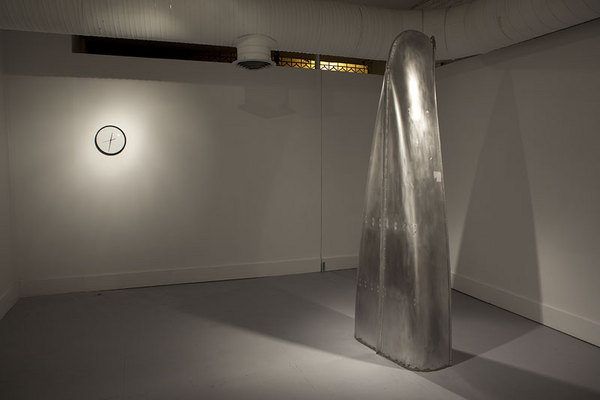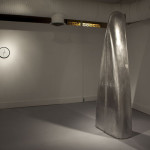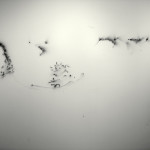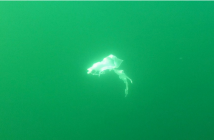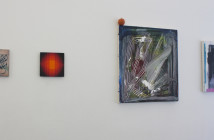Comedy refuses mortality. That is Buster Keaton's lesson, and why, I think, he is a greater artist than Charlie Chaplin. There is something too elaborately contrived about all of Chaplin's encounters with disaster; he simpers too much to ever make the threats he faces seem credible. Although Keaton is never surprised by the possibilities of violence which the world offers, he knows that they are real. Doomed, but unmoved, his persistence is never smug or self-conscious. Always on the edge of extinction, Keaton knows that comic timing is merely a temporary salvation which may well fail on the next go around. But the sounds of laughing are what keep the absurdity at bay. Samuel Beckett tried to honor that in the work Film, which he wrote for Keaton, but all he could do was remind you of what Keaton had already done on his own.
This may seem a curious way into William Lamson's most recent work, but I could not help thinking of the silent film artist when I encountered Lamson's new project. This was true as well of my response to several earlier pieces Lamson produced, especially the short animation Yard, or the bloodlessly violent video Duel. They share a sense of hilarity as a form of consolation, even if a fragile one. Laughter in the midst of darkness is at its most powerful.
In the central video of the work, the pair of what appear to be two separate small boats are rowed together and reassembled as a single canoe. Then, as the camera's field widens, the small frame of water becomes the East River and the Brooklyn Bridge, and then the mass of the city. Indomitable, the small craft persists. In Keaton's film, The Balloonatic, another comic canoe, similarly sectioned, becomes an unexpected vehicle for escape from time running out in a large universe.
In the opposite gallery, a grid of arrows just below the ceiling measures the dimensions of space, with the video tape segments stretched between them serving as time frames without conventional sequence. Their beginning and end look absolutely the same; one can consider them from either direction. Does this realize Zeno's Paradox: the arrow that is both still and in motion at the same moment? On the floor beneath them is a paused video screen in permanent blue. It is a reminder that the recorder is a small time machine, its wind and rewind controls at play with chronology. There is the joy of reversing the world, or, as in Kurt Vonnegut's image of a World War II bombing run played backwards, the restoration of it.
There is also a further variation on the notion of "automatic" drawing, here produced by burning fuses and small firecrackers. This time period had two beginnings, and one end, where the ignited strands extinguished themselves. As with the "canoe drawing" in another gallery where the artist creates a motion machine, time writes its own history.
As for clocks, they appear with a difference. One measures the particular occasion of a slack tide, that moment of balance near both high and ebb. The back and forth before and after that moment is registered by hands that move in reverse as well as forward. In a separate piece entitled Drip (So Are the Days of Our Lives),the hourglass form is inverted, with its sand eroded by slowly dripping water rather than falling free, the finite principle in a shower stall.
There is anguish here, too. The bows used to fashion the patterns of arrows stand at one end of a long gallery, mirroring one another, like the weapon of Philoctetes, the Greek warrior abandoned with an incurable wound on the way to Troy. This measure of time would be pain. And in the timeline that is like a pattern of miniature explosions on the surface of a wall, what might be a work total destruction appears small at a distance. And the arrows are also a drawing, like the remains of some medieval Japanese siege imagined by Kurosawa, with the wooden fortress walls measured out by the shafts thick on them.
But this is where comedy counts for the most, standing over and against a reality often too difficult to bear. There is no place you can go at the moment to learn more about the nature of time than in this work of William Lamson's. And no place where we are offered the gift of such a brilliant joke about our passing away. In one photograph, stretched between the two pieces of his bifurcated canoe, Lamson is poised above a minor void. But we know that he will be saved, and that we can laugh at that.
- William Lamson, Installation views of Time is Like the East River, 2009. (photographs courtesy of the artist).
"William Lamson: Time is Like The East River" is on view November 12 - December 19, 2009 at Artspace, in New Haven, CT.
All images are courtesy of the artist and Artspace.
- See more at: http://www.bigredandshiny.com/cgi-bin/BRS.cgi?section=review&issue=121&article=2009111311134475071185495#sthash.WBf5sRME.dpuf

